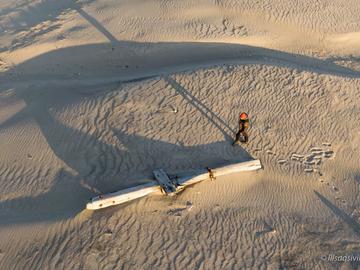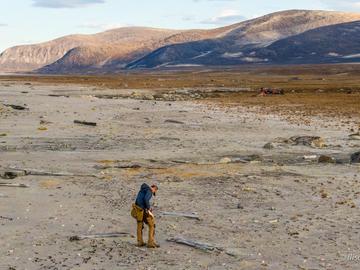March 4, 2020
Researchers bring sunken ships and forgotten histories of the Arctic to Calgary

When the Nova Zembla set sail from Dundee, Scotland, it was on a whaling expedition, like thousands of ships before it. The Scottish whaling vessel struck a reef off the east coast of Baffin Island on Sept. 18, 1902, while seeking shelter from a storm.
The boat sunk fast, a cargo hold full of blubber and whalebone going down with it. The crew was rescued by fellow whaling ships, and the valuable whalebone was retrieved — but the final location of the shipwreck was unknown to western historians until two years ago.
On a trip to Nunavut in 2018, Arctic Institute of North America researchers Dr. Matthew Ayre, PhD, and Dr. Michael Moloney, PhD, discovered the wreckage of Nova Zembla, after months spent tracing the paper trail of the ship and its crew.
Using drones and sonar imaging, Ayre and Moloney tracked down the wreckage. Their expedition was a short one, but they gathered images showing man-made ship materials. The Nova Zembla remains in pieces, both at the bottom of Buchan Gulf and strewn across nearby beaches.
And now they’re ready to go back.
“This summer we are planning our most ambitious expedition to date, where we will spend 10 days at this very remote site,” says Ayre. “We will continue our investigation and survey of Nova Zembla’s wreck, both on the beach and underwater. We will also make preliminary investigations into a second, earlier wreck which newly unearthed historical documents point to being close by.”
Ayre and Moloney will work with local Inuit communities to learn more about the history of the Nova Zembla, and also look for evidence of Olnick, an Inuk from the area. Olnick regularly traded with the whalers in the area, and spent a year living in Dundee at his own request, where he was invited to meet with the Prince of Wales before returning to Baffin.
Another treasure found
One of the many challenges in identifying the wreckage is a lack of materials that show the ship in its original, intact form. “There are a handful of photographs of Nova Zembla, but they are black and white and it is hard to pick out much detail in them,” says Ayre.
Ayre knew of a painting of the Nova Zembla, painted by James Orchison in 1884 — but he had no records that showed its whereabouts. “In summer 2019, I dedicated some time to trying to track down this painting,” he says. “To my surprise I found it for sale in a small antiques store in Pennsylvania! Dr. Ron Wallace, a friend and supporter, unbeknownst to me went and purchased the painting on behalf of the project.”
The painting has since been restored, and will be on display for the first time at the talk at the Central Library.
A ‘forgotten chapter’ of Arctic history
The Nova Zembla is an important find in this largely unknown part of Canadian Arctic history. “The Arctic whaling industry was big business and thousands of ships were sent to Davis Strait and Baffin Bay in the 18th and 19th century to hunt for Bowhead whales, rendering down their blubber for oil,” says Ayre.
The whaling industry shaped the modern world — whale oil gave light to the first street lights, which led to the beginning of evening culture. It provided lubrication for machinery, treatment for textiles and the base for soap. At one point it was a mainstay of the women’s fashion industry, with baleen forming the necessary supports for corsets and petticoats.
“This research sheds light on where our modern society came from, who the people involved in it were, how they lived and who they interacted with,” says Ayre. “There is very little primary documentation surviving from the trade and almost no identified archaeological evidence, save for Nova Zembla.”
The Nova Zembla expedition project is sponsored by the Arctic Institute of North America, The Royal Canadian Geographical Society, the Government of Nunavut, Ittaq, Dr. Ron Wallace, and Mike and Jane Wilson.
The Arctic Institute of North America is Canada’s first and longest-lived Arctic research institute. AINA was created by an Act of Parliament in 1945 as a nonprofit, tax-exempt research and educational organization and has been a part of the University of Calgary since 1976.









